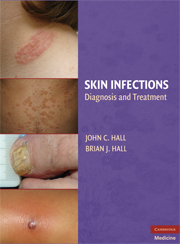Book contents
- Frontmatter
- Contents
- List of Contributors
- Acknowledgments
- INTRODUCTION
- TECHNIQUES IN DIAGNOSING DERMATOLOGIC MANIFESTATIONS OF INFECTIOUS DISEASES
- PRINCIPLES OF MANAGEMENT OF DERMATOLOGIC INFECTIONS IN THE SKIN
- PART 1 COMMON INFECTIONS
- PART II LESS COMMON INFECTIONS
- PART III INFECTIONS IN SELECTED ECOSYSTEMS
- 10 INFECTIONS IN THE DESERT
- 11 INFECTION IN THE TROPICS
- 12 AQUATIC DERMATOLOGY
- PART IV INFECTIONS IN SELECTED PATIENT POPULATIONS
- PART V INFECTIONS OF SPECIFIC SKIN-ASSOCIATED BODY SITES
- PART VI SPECIAL DISEASE CATEGORIES
- Index
11 - INFECTION IN THE TROPICS
from PART III - INFECTIONS IN SELECTED ECOSYSTEMS
Published online by Cambridge University Press: 08 January 2010
- Frontmatter
- Contents
- List of Contributors
- Acknowledgments
- INTRODUCTION
- TECHNIQUES IN DIAGNOSING DERMATOLOGIC MANIFESTATIONS OF INFECTIOUS DISEASES
- PRINCIPLES OF MANAGEMENT OF DERMATOLOGIC INFECTIONS IN THE SKIN
- PART 1 COMMON INFECTIONS
- PART II LESS COMMON INFECTIONS
- PART III INFECTIONS IN SELECTED ECOSYSTEMS
- 10 INFECTIONS IN THE DESERT
- 11 INFECTION IN THE TROPICS
- 12 AQUATIC DERMATOLOGY
- PART IV INFECTIONS IN SELECTED PATIENT POPULATIONS
- PART V INFECTIONS OF SPECIFIC SKIN-ASSOCIATED BODY SITES
- PART VI SPECIAL DISEASE CATEGORIES
- Index
Summary
INTRODUCTION
Infections diseases in the tropics, such as leishmaniasis, sleeping sickness (African trypanosomiasis), malaria, and Chagas' disease, which generate a devastating impact on humanity, are frequently refered to as neglected diseases, and affect mainly poor people.
According to the World Health Organization (WHO), there are around 530 million people – or almost one-tenth of the world population – suffering from some of these so-called neglected diseases. The number of people at risk for infection, however, is much greater. 40% of the world's population is at risk of acquiring malaria; 25% of the Latin American population is in danger of acquiring Chagas' disease; 55 million Africans are exposed to sleeping sickness, and leishmaniasis threatens another 350 million people around the world.
Affecting the skin, they are called dermatoses of the tropical and substropical area, dermatoses of the poor (a term used by James Marshall), dermatoses of the developing and underdeveloped countries; and also dermatoses of malnutrition, illiteracy, sun radiation, humidity, and insect bites.
Tropical dermatosis is a difficult term to define, according to Canizares. Simmons stated that a tropical disease is one that “by virtue of its etiology, occurs, either exclusively or predominantly, in a tropical or substropical region, where though not strictly endemic, it is either autochthonous or in residence, since it has been repulsed from other areas by hygienic measures”.
The factors that most influence the development of tropical dermatoses are climatic, ecological, human, cultural, and socio-economic factors.
- Type
- Chapter
- Information
- Skin InfectionsDiagnosis and Treatment, pp. 150 - 166Publisher: Cambridge University PressPrint publication year: 2009



